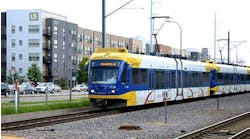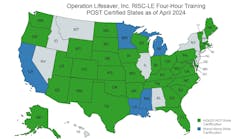U.S. Transportation Secretary Ray LaHood today announced a federal loan of up to $280 million to advance construction on the 30-mile Eagle P3 commuter rail project, which will significantly expand transportation choices in the greater Denver area."This loan brings Denver a step closer to completing this ambitious and far-reaching project that offers better transportation choices in one of the most densely populated regions of the country," Secretary LaHood said. "We're proud to promote a solid foundation for the region's economic growth, while creating thousands of good jobs in Colorado."
The project is a two-pronged effort. The western segment of Eagle P3, known as the Gold Line, will serve the suburbs of Arvada and Wheat Ridge. The East Line will run from Denver's historic Union Station nearly 23 miles east to Denver International Airport and will connect to existing light rail and bus service. Both lines are under construction and roughly 4,700 construction-related jobs are expected to be generated by the work.
The Department's Transportation Infrastructure Finance and Innovation Act (TIFIA) program, which provides credit assistance for infrastructure projects, is the source of the loan to the Denver Regional Transportation District (RTD). This funding boost is in addition to a $1 billion federal funding agreement for the project signed in August by Secretary LaHood and Federal Transit Administrator (FTA) Peter Rogoff.
RTD is the first transit agency in the nation to successfully pursue a comprehensive public-private partnership, or P3, that draws on a mix of federal loans and grants and private investment to move major capital transit projects in the region forward. The partnership encompasses all phases of design, construction, financing, operation and maintenance.
"Denver and its partners are working together to build a modern rail transit system that promises to cut almost in half the time it now takes to get from downtown Denver to the airport," said FTA Administrator Peter Rogoff. "Today's investment helps to ensure that the construction work already under way remains on track, and that thousands of workers can count on a steady paycheck."
RTD will use the TIFIA loan to fund a portion of its contribution to the project and will begin drawing on the funds in 2013. In addition to FTA's contribution to the project, a consortium of private companies, known as the Denver Transit Partners, is responsible for financing around 24 percent of the project through tax-exempt private-activity bonds issued by RTD, equity contributions and other means.
The entire project should be completed in 2016. The new railcars slated for use on the commuter line will be assembled in the United States and will consist of at least 60 percent US-made components, consistent with the FTA's Buy America requirements.
Together, the Eagle P3 project and Denver Union Station's ongoing renovation are part of RTD's far-reaching FasTracks program—a voter-approved, multiyear, multibillion-dollar transit expansion program covering 140 miles of rail and bus corridors that will help Denver to successfully manage growth and compete for business for years to come.


